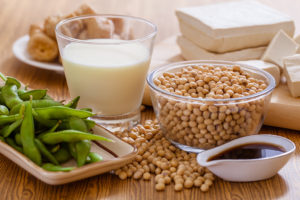
Each phase of life brings its own joys and challenges.
For women, menopause is one of those challenges. It’s part of the natural aging process, in which the ovaries no longer make estrogen or progesterone.
One of the main complaints from women going through menopause is hot flashes.
There has been much research into soy’s role in relieving hot flash symptoms, given the high isoflavone content. Isoflavones change into phytoestrogens within the body, similar to the hormone estrogen.
Soy has been a staple food for centuries, especially in Asia. It is entirely common to Western diets now, in the form of soy milk and tofu, for instance, and in fermented products such as soy sauce, fermented bean paste, natto and tempe.
The University of Berkley provides a wonderfully descriptive list of the many varieties of soy products on the market, as well as detailing some of the nutritional content of each.
The high-protein content of most soy products makes them ideal as vegetarian protein sources. They’re commonly used as vegetarian “meat” products.
Researchers have looked into soy’s beneficial effects on various health conditions, including high cholesterol, osteoporosis and breast cancer. They’ve also found a modest decrease in the frequency and severity of hot flashes in women who consume some soy.
While this may be great news for those looking for alternatives to traditional hormone replacement therapy, caution should be heeded—especially for those who tend to use any substance in high amounts.
Women with thyroid diseases or estrogen-receptor positive breast cancers should take additional precautions and consult their primary care physician and a registered dietitian before making any alterations to their diet.
Research has suggested that long-term use of high doses of soy isoflavone tablets may increase the chances of developing endometrial cancer. Some women may also experience various mild side effects with increased soy intake, including constipation, diarrhea, bloating and nausea.
As with other seeds and beans, soy also contains a high amount of phytic acid, which blocks absorption of important minerals.
What’s the bottom line? As with most foods we consume, moderation is key.
You should try to eat soy items in whole form, as opposed to supplements or processed “meat” products.
Try incorporating soy products into your balanced diet using whole, unprocessed products. Soy milk can replace milk, while meatless dishes can be created by using tofu or tempe. And let edamame or soybeans become your afternoon snacks.
It’s also important to understand that it can take anywhere from a few weeks to a month before you begin to see the positive effects of soy consumption. Generally you’ll need up to 50 milligrams of soy isoflavones to see any benefits.
In particular, the genistein-specific isoflavones or the daidzein-specific isoflavones provide the greatest benefit at 15 milligrams or 28 milligrams per day, respectively.
If you’d like to understand some of the food science behind soy, Oregon State University has a fascinating article that breaks down the particulars of soy isoflavone compounds and how the body metabolizes them.
 /a>
/a>
 /a>
/a>
 /a>
/a>